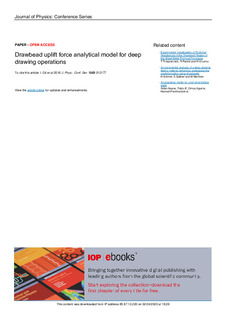Title
Drawbead uplift force analytical model for deep drawing operationsPublication Date
2018Version
Published versionDocument type
Journal ArticleJournal ArticleLanguage
EnglishAccess
Open accessPublisher’s version
http://dx.doi.org/10.1088/1742-6596/1063/1/012177Published at
Journal of Physics: Conference Series Vol. 1063. Nº 1. 6 August, 2018Publisher
IOP Publishing Ltd.Abstract
Drawbead uplift force calculation has been an open issue among the deep drawing tool maker and software developers in the last years. Starting from the original work of Stoughton (1988) many have been ... [+]
Drawbead uplift force calculation has been an open issue among the deep drawing tool maker and software developers in the last years. Starting from the original work of Stoughton (1988) many have been the models presented in order to improve the predictions. However, still nowadays, the main deep drawing software are not able to accurately predict the uplift force and clear example of that are the intensive effort of the software developers in that topic as well as the conversion factors used by the main OEM when acquiring a new tool. In this work, a new semi-analytic model of drawbead closing force calculation is presented. The model is not only able to predict the uplift force for different steps of the closing (very useful for the set-up process) but it has been validated when using a high strength steel (DP780) for different drawbead configuration. [-]
xmlui.dri2xhtml.METS-1.0.item-sponsorship
Gobierno de Españaxmlui.dri2xhtml.METS-1.0.item-projectID
GE/Retos-Colaboración del Programa Estatal de Investigación, Desarrollo e Innovación Orientada a los Retos de la Sociedad, en el marco del Plan Estatal de Investigación Científica y Técnica y de Innovación 2013-2016. RTC-2015-3643-4/ES/Nueva generación de troqueles más estables y con vida útil prolongada para el conformado de aceros avanzados de alto límite elástico para automoción/HRDCollections
- Articles - Engineering [763]
The following license files are associated with this item:






















